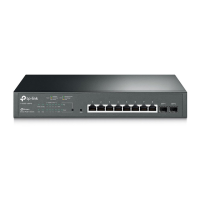JetStream 52-Port Gigabit Stackable L3 Managed Switch CLI Guide
smode —— The Security Model of the management station, with v1, v2c and
v3 options. By default, the option is v1.
slev —— The Security Level of SNMP v3 Group. There are three options,
including noAuthNoPriv (no authorization and no encryption), authNoPriv
(authorization and no encryption) and authPriv (authorization and encryption).
By default, the option is “noAuthNoPriv”.
type —— The type of the notifications, with trap and inform options. Trap
indicates traps are sent, while inform indicates informs are sent. The inform
type has a higher security than the trap type and resend and timeout need to
be configured if you select this option. You can only select the trap type in
Security Model v1. By default, the type of the notifications is “trap”.
retries
—— The amount of times the switch retries an inform request, ranging
from 1 to 255. The switch will resend the inform request if it doesn’t get the
response from the management station during the Timeout interval, and it will
terminate resending the inform request if the resending times reach the
specified Retry times.
timeout
—— The maximum time for the switch to wait for the response from
the management station before resending a request, ranging from 1 to 3600
in seconds.
Command Mode
Global Configuration Mode
Example
Add a Notification entry, and configure the IP address of the management
Host as 192.168.0.146, the UDP port as 162, the User name of the
management station as admin, the Security Model of the management station
as v2c, the type of the notifications as inform, the maximum time for the
switch to wait as 1000 seconds, and the retries time as 100:
T3700G-52TQ(config)#snmp-server host 192.168.0.146 162 admin smode
v2c type inform retries 100 timeout 1000
35.6 snmp-server engineID
Description
The snmp-server engineID command is used to configure the local and
remote engineID of the switch. To restore to the default setting, please use
no snmp-server engineID command.
295

